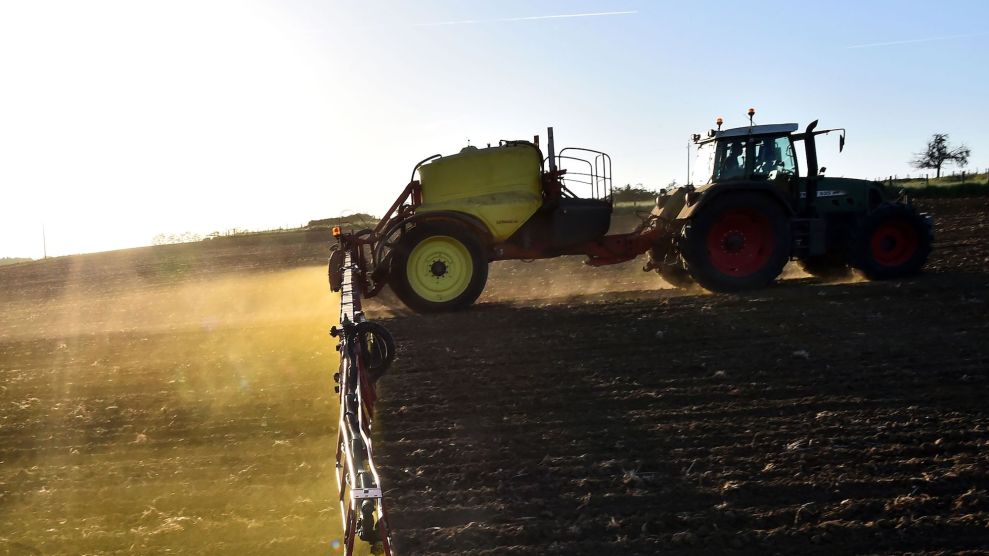
A farmer in France sprays glyphosate herbicide on a field of corn. Jean-Francois Monier/Getty/AFP
UPDATE (3/19/2019): On Tuesday afternoon, a US District Court jury ruled in favor of plaintiff Edwin Hardeman in phase 1 of his lawsuit against Bayer. Hardeman claims exposure to the company’s herbicide caused his case of non-Hodgkin’s lymphoma. In phase 1 of the trial, the jury was asked to decide whether glyphosate use was a “substantial factor” in causing Hardeman’s cancer; phase 2, which begins before the same jury Wednesday, will consider Monsanto’s liability and damages.
UPDATE (3/27/2019): The jury awarded Edwin Hardeman $80 million in damages based on his claim that RoundUp caused his cancer. According to the AP, the case is especially significant “because the judge is overseeing hundreds of Roundup lawsuits and has deemed it a ‘bellwether trial.'”
The long-simmering debate about whether the world’s most widely used herbicide causes cancer has bubbled up anew. Glyphosate is the key component of weedkillers such as Monsanto’s Roundup. On March 12, attorneys made closing arguments in San Francisco on the first phase of a closely watched lawsuit against German chemical giant Bayer, which acquired Monsanto last year. Plaintiff Edwin Hardeman claims his use of Roundup caused him to develop non-Hodgkin lymphoma (NHL), a type of cancer.
The jury is expected to decide Friday whether glyphosate-based weedkillers were a “substantial factor” in causing Hardeman’s cancer, as US District Court Judge Vince Chhabria put in his instructions to jurors. If they rule unanimously in Hardeman’s favor, the trial’s second phase will consider Monsanto’s liability in the case. A split decision from the jury will result in a mistrial and likely trigger a new trial for Hardeman.
Major regulatory agencies in the United States and Canada have concluded that glyphosate is not carcinogenic. But the chemical remains under scrutiny. Just weeks before the start of the Hardeman trial, several researchers who once served on a government panel assessing glyphosate’s safety released a new study suggesting people exposed to large doses of the chemical have a heightened risk for NHL. Two of the expert witnesses in the Hardeman case cited the study during their testimony.
The researchers performed a meta-analysis of the epidemiological research around glyphosate and non-Hodgkin lymphoma. In a meta-analysis, scientists combine and analyze data from multiple studies and look for broad trends in the research. The team found a “compelling link” between exposure to glyphosate-based weedkillers and NHL. The study concluded that people exposed to glyphosate at the highest levels have 41 percent higher risk of contracting non-Hodgkin lymphoma than people who aren’t, a measure known as “relative risk” in epidemiology.
Rachel Shaffer, a co-author of the paper and a PhD student in environmental toxicology at the University of Washington, put that number into context in a blog post: The results suggest that people who are highly exposed to glyphosate have a roughly 2.8 percent risk of contracting NHL, versus about 2 percent for the overall population.
A spokeswoman for Bayer flatly disputed the study’s findings, writing in an emailed statement that it contains “no scientifically valid evidence that contradicts the conclusions of the extensive body of science demonstrating that glyphosate-based herbicides are not carcinogenic.”
Agencies including the US Environmental Protection Agency, Health Canada, and the European Food Safety Authority have concluded that glyphosate is unlikely to cause cancer, and they continue to allow its widespread use. The World Health Organization’s International Agency for Research on Cancer, on the other hand, decided in 2015 that glyphosate is “probably carcinogenic to humans.” That finding prompted charges that IARC had reached that conclusion by willfully ignoring then-unpublished research that might have exonerated glyphosate, a controversy my colleague Kiera Butler laid out here. IARC, in turn, has pushed back against those allegations.
Monsanto grew into one of the globe’s largest agribusiness firms largely on the strength of its blockbuster glyphosate weedkillers and associated products. In buying the smaller US company, Bayer inherited not only those assets but also lawsuits from approximately 11,200 plaintiffs claiming “personal injuries resulting from exposure to those products, including non-Hodgkin lymphoma and multiple myeloma,” Bayer noted in its 2018 annual report. Last August, a California jury awarded $289 million in damages to a groundskeeper who argued glyphosate exposure gave him NHL. (A judge later reduced the award to $78 million, but didn’t strike down the jury’s judgement that Monsanto had acted with malice—a ruling Bayer is appealing.) Bayer stock has lost nearly 30 percent of its value since last August’s big jury award—a possible measure of just how much the question of glyphosate’s status as a carcinogen hangs over the company.
Glyphosate has had a rocky road through the US regulatory process, a journey all too familiar to three of the new NHL study’s co-authors: Berkeley toxicologist Luoping Zhang, Mount Sinai epidemiologist Emanuela Taioli, and University of Washington biostatistician Lianne Sheppard. All three scientists served on the EPA Scientific Advisory Panel that evaluated the chemical in 2016. While the EPA ultimately declared the herbicide non-carcinogenic, the 15-member panel was divided, as the EPA’s final report on the panel’s feedback and the transcript of its December 2016 meetings show.
Judging the carcinogenic potential of a pesticide is tricky. For one, you can’t ethically dose people with potentially harmful chemicals and then see what happens. And even if you could, cancers can take years to develop. So researchers generally take a three-pronged approach: They study populations known to have been exposed to the chemical and look for disease patterns, a practice called epidemiology; they study the effects on animals like rats or mice dosed with the chemicals; and they test whether the chemical shows potential in a lab setting to harm a cell’s DNA and thus potentially cause cancer, also called genotoxicity.
The EPA’s scientific advisory panel was charged with sifting through studies of all three types and making a judgement based on the weight of evidence. On all three fronts, dissenting voices emerged. The final report noted that based on studies of populations known to be exposed to the herbicide, “some Panel members believed that there is limited but suggestive evidence of a positive association between glyphosate exposure and risk of NHL.” On animal research, the report found that in “the view of some Panel members, there are sufficient data to conclude glyphosate is a rodent carcinogen.” On genotoxicity, members pointed to “remaining uncertainty” about several potential ways glyphosate might damage cells.
“Far from settling the matter” of the carcinogenicity of the chemical, “eight of the 15 experts expressed significant concerns about the EPA’s benign view of glyphosate, and three more expressed concerns about the data,” Bloomberg Businessweek reported in 2017. Ultimately, the EPA “tied themselves in knots to reach the conclusion that they reached—the evidence and the conclusions just didn’t align well at all,” Sheppard, a panel member and co-author of the new NHL study, told me.
Frustrated by the process, Sheppard and co-panelists Zhang and Taioli decided to band together and investigate what they thought was a particular point of concern in the existing epidemiological research: whether glyphosate might be linked to increased risk to non-Hodgkin lymphoma.
Three previous recent meta-analyses had detected an association—see here, here, and here. (All three surfaced in testimony during the Hardeman trial.) When Sheppard and her co-authors embarked on their own meta-analysis, they were able to incorporate an important cache of data that the earlier studies had not: the latest results of the Agricultural Health Study, a large, multi-decade project led by scientists at the US National Cancer Institute to track health outcomes among US agricultural workers and their families.
The AHS results had previously been analyzed by a research team led by Gabriella Andreotti of the National Cancer Institute for a 2018 paper that found “no association” between glyphosate and cancer, “including NHL and its subtypes.”
Sheppard’s team focused on one subset of the same AHS data: the study participants who were exposed to the chemicals at the “highest biologically relevant” levels, with a long-enough time lag for cancer to develop. In their statistical analysis, Andreotti and her team sorted participants who had been exposed to glyphosate into two groups—those with a 20-year lag since exposure, and those with a five-year lag. Among those groups, they broke them into four groups, from least exposed to most exposed. Sheppard and her team used data from the highest-exposed, 20-year-lag subset. This group showed a 12 percent relative risk for NHL. That finding is “not statistically significant” on it own, Sheppard said. But when averaged with data from the five other studies in their meta-analysis, it contributed to their finding of a “compelling link” between glyphosate herbicides and NHL, she said.
A Bayer spokeswoman called the paper a “statistical manipulation” and accused it of having a “number of serious methodological flaws.” Bayer’s statement claims the study “cherry-picks data” and “combines incompatible data” from the studies under review to get the result.
Sheppard disagreed with the claims, including the suggestion that the team cherry-picked data. She noted that the researchers state in their hypothesis that they planned to focus on “the highest exposed groups,” an established way to test for carcinogenicity. The charge of “combining incompatible data,” she said, could be leveled at any meta-analysis—which, by definition, combines data from multiple studies with different structures.
In an interview, Laura Beane Freeman, senior investigator for the National Cancer Institute and a co-author of the 2018 AHS paper, said the Sheppard team was “very transparent in the numbers that they chose” and deemed their study “relatively consistent with the other published meta-analyses on the topic.”
However, she added, the assumption that NHL typically requires a 20-year latency period is “probably not as well established as they assert in their meta-analysis.” She also noted that the 20-year lag group did not show a consistent pattern of cancer rates increasing with exposure rates. Beane Freeman’s team put glyphosate-exposed participants into four groups, from least exposed (group 1) to most exposed (group 4)—the group Sheppard and her team chose. Group 1 showed a relative risk of 1.22, which is higher than group 4’s 1.12. “Usually, with cancer, you would sort of expect the more exposure you have, the higher the risk that you have,” Beane Freeman said.
So what to make of all of this? Of the dozen epidemiologists and cancer researchers I reached out to for an independent assessment of the Sheppard team’s paper, only one other scientist agreed to speak to me: University of California-San Francisco’s Tracey Woodruff, who studies how exposure to environmental chemicals affects early development. She called the Sheppard team’s study an “important addition to the literature” and a “well-done study that brings new insight into the relationship between glyphosate exposure and non-Hodgkin’s lymphoma.”
In a March 7 order denying Bayer’s move to have the Hardeman case dismissed, the presiding judge, Vince Chhabria, wrote that the company relied “almost entirely on the epidemiological data” to claim that Hardeman’s legal team “have failed to present ‘competent evidence’ that any risk from glyphosate was ‘known or knowable’ by the scientific community at the time the plaintiffs used Roundup.” But, Chhabria wrote, “the epidemiology is far from undisputed,” and he cited a 2003 study that’s part of the Sheppard team’s meta-analysis to underline his point. The company “cannot prevail on a motion” to dismiss the case “by simply ignoring large swaths of evidence,” he wrote.
Meanwhile, as questions about glyphosate’s carcinogenicity loom, use of the chemical continues unabated. The US agricultural sector went from applying less than 25 million pounds of the stuff in 1992 to nearly 300 million pounds in 2016. In 2019, the US Department of Agriculture expects farmers to plant more than 177 million acres of corn and soybeans—covering a land mass roughly equivalent in size to around 1.75 Californias—the great bulk of them treated with glyphosate-based herbicides.














